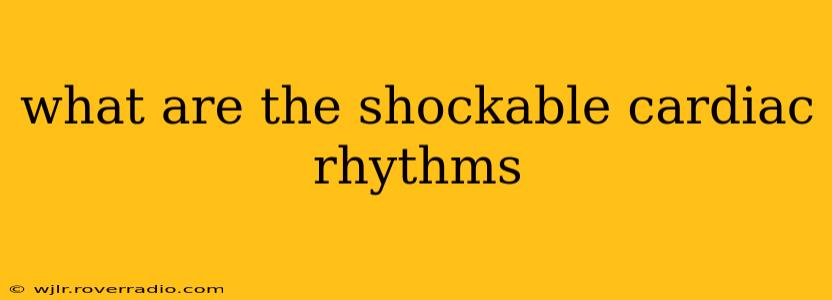What Are the Shockable Cardiac Rhythms?
Understanding shockable cardiac rhythms is crucial in emergency medical situations. Defibrillation, the process of delivering a controlled electrical shock to the heart, is a life-saving intervention but only effective for specific, life-threatening arrhythmias. Improper use can be dangerous, so accurate identification is paramount. This article will explain which rhythms are considered shockable and why.
What is Defibrillation?
Before delving into the rhythms themselves, let's briefly clarify what defibrillation achieves. The heart's electrical system controls its contractions. When a life-threatening arrhythmia occurs, the heart's chambers may quiver chaotically (ventricular fibrillation) or beat too fast and ineffectively (ventricular tachycardia). Defibrillation aims to depolarize a large mass of myocardial cells simultaneously, allowing the heart's natural pacemaker to regain control and re-establish an organized rhythm.
The Two Main Shockable Rhythms:
The two primary shockable rhythms are:
-
Ventricular Fibrillation (VF): This is a chaotic, disorganized quivering of the ventricles (the heart's lower chambers). There is no effective heartbeat, resulting in no blood flow to the body. VF is a life-threatening emergency requiring immediate defibrillation. On an ECG, VF appears as irregular, wavy lines with no discernible P waves, QRS complexes, or T waves.
-
Pulseless Ventricular Tachycardia (pVT): This rhythm is characterized by a rapid, chaotic heartbeat originating in the ventricles. While there is electrical activity, the heart's contractions are ineffective, leading to no palpable pulse and no blood flow. Pulseless VT is equally life-threatening and requires immediate defibrillation. The ECG shows rapid, wide QRS complexes without discernible P waves.
Why Are These Rhythms Shockable?
These rhythms are shockable because they represent a complete absence of effective cardiac output. Defibrillation offers the best chance of restoring a perfusing rhythm by synchronizing the heart's electrical activity and allowing the natural pacemaker to resume its function.
H2: What Rhythms Are NOT Shockable?
It's equally important to understand which rhythms are not considered shockable. Applying a shock to these rhythms can be dangerous and ineffective. Examples include:
-
Asystole (flatline): In asystole, there is no electrical activity in the heart. Defibrillation is futile as there are no electrical impulses to reset. CPR and medications are the appropriate interventions.
-
Pulseless Electrical Activity (PEA): PEA is a condition where organized electrical activity is present on the ECG, but there is no palpable pulse and no effective blood flow. The electrical impulses are not strong enough to generate effective contractions. CPR and medications are the primary treatments, not defibrillation.
-
Organized Rhythms with a Pulse: Rhythms such as sinus tachycardia (fast heart rate) or supraventricular tachycardia (rapid heart rate originating above the ventricles), even if rapid, are generally not shockable unless they are pulseless. Other treatments are usually more appropriate.
H2: What are the risks associated with defibrillation?
While defibrillation is a life-saving procedure, there are potential risks associated with it. These include:
- Burns: Improper placement of the pads can cause burns to the skin.
- Rib fractures: The jolt from the shock can sometimes cause rib fractures.
- Medication interactions: Defibrillation can interact with certain medications.
- Arrhythmias: While attempting to correct one arrhythmia, another might be inadvertently induced.
H2: How is a shockable rhythm diagnosed?
Shockable rhythms are diagnosed primarily through electrocardiography (ECG). ECG monitors display the heart's electrical activity, allowing healthcare professionals to identify VF and pVT. Rapid and accurate interpretation of the ECG is crucial for timely intervention.
H2: Can a non-medical professional administer defibrillation?
In many settings, Automated External Defibrillators (AEDs) are readily available. AEDs are designed to be user-friendly and guide the user through the process of defibrillation, allowing even untrained individuals to administer a potentially life-saving shock. However, proper training is recommended to ensure safe and effective use.
This information is for educational purposes only and does not constitute medical advice. Always consult with a qualified healthcare professional for diagnosis and treatment.
